Characterization and Prediction of Air Transport Delays in China
Abstract
1. Introduction
2. Literature Review
3. Data and Methods
3.1. Delay Data Set Description
- ICAO (International Civil Aviation Organization) code of scheduled departure/arrival airport;
- ICAO code of actual departure/arrival airport;
- Unixtime (time in seconds since 1 January 1970) for scheduled departure/arrival time;
- Unixtime (time in seconds since 1 January 1970) for actual departure/arrival time.
3.2. Weather Data Set Description
- Temperature: air temperature in degrees Celsius.
- Wind speed: speed of the main steady wind (i.e., not considering gusts) in knots.
- Rain: fraction of times the word “rain” appears in the “WX” part (present weather phenomena) of the METAR message. A value of thus indicates that rain was reported in 24 of the 48 messages available for one given day, i.e., for a total of 12 h.
- Visibility: horizontal visibility measured in statute miles. Values higher than 10 have been rounded to 10.
- Thunderstorms: similarly to the rain metric, fraction of times the word “thunderstorm” appears in the “WX” part (present weather phenomena) of the METAR message.
3.3. Air Quality Data Set Description
3.4. Prediction Models
- Random Forests (RF). Combinations of Decision Trees predictors, in which each tree is trained over a random subset of features and records; the final classification forecast is then calculated through a majority rule. Random Forests are especially appreciated for their precision and low tendency of overfitting [32].
- Stochastic Gradient Descent (SGD): meta-algorithm in which multiple linear Huber loss functions are combined and optimized [33].
- Multi-Layer Perceptron (MLP): based on the structural aspects of biological neural networks, MLPs are composed of a set of connected nodes organized in layers. Each connection has a weight associated to it, which is tuned through the learning phase [34]. When more than two layers are included in the model, it can be proven that MLPs can classify data that are not linearly separable, and in general approximate any non-linear function.
4. Statistical Analysis of Flight Delays in China
5. Effect of Weather on Delay Dynamics
5.1. Statistical Analysis
5.2. Delay Prediction
6. Discussion and Conclusions
Author Contributions
Funding
Conflicts of Interest
References
- Cook, A.; Belkoura, S.; Zanin, M. ATM performance measurement in Europe, the US and China. Chin. J. Aeronaut. 2017, 30, 479–490. [Google Scholar] [CrossRef]
- Ball, M.; Barnhart, C.; Dresner, M.; Hansen, M.; Neels, K.; Odoni, A.R.; Peterson, E.; Sherry, L.; Trani, A.; Zou, B. Total Delay Impact Study: A Comprehensive Assessment of the Costs and Impacts of Flight Delay in the United States. National Center of Excellence for Aviation Operations Research Final Report. 2010. Available online: http://www.isr.umd.edu/NEXTOR/rep2010.html (accessed on 3 August 2020).
- Civil Aviation Administration of China. Statistical Bulletin of Civil Aviation Industry Development in 2015; Civil Aviation Administration of China: Beijing, China, 2015. [Google Scholar]
- Baumgarten, P.; Malina, R.; Lange, A. The impact of hubbing concentration on flight delays within airline networks: An empirical analysis of the US domestic market. Transp. Res. Part E Logist. Transp. Rev. 2014, 66, 103–114. [Google Scholar] [CrossRef]
- Britto, R.; Dresner, M.; Voltes, A. The impact of flight delays on passenger demand and societal welfare. Transp. Res. Part E Logist. Transp. Rev. 2012, 48, 460–469. [Google Scholar] [CrossRef]
- Aydemir, R.; Seymour, D.T.; Buyukdagli, A.; Guloglu, B. An empirical analysis of delays in the Turkish Airlines network. J. Air Transp. Manag. 2017, 65, 76–87. [Google Scholar] [CrossRef]
- Belkoura, S.; Peña, J.M.; Zanin, M. Generation and recovery of airborne delays in air transport. Transp. Res. Part C Emerg. Technol. 2016, 69, 436–450. [Google Scholar] [CrossRef]
- Santos, G.; Robin, M. Determinants of delays at European airports. Transp. Res. Part B Methodol. 2010, 44, 392–403. [Google Scholar] [CrossRef]
- Borsky, S.; Unterberger, C. Bad weather and flight delays: The impact of sudden and slow onset weather events. Econ. Transp. 2019, 18, 10–26. [Google Scholar] [CrossRef]
- Fukui, H.; Nagata, K. Flight cancellation as a reaction to the tarmac delay rule: An unintended consequence of enhanced passenger protection. Econ. Transp. 2014, 3, 29–44. [Google Scholar] [CrossRef]
- Gayle, P.G.; Yimga, J.O. How much do consumers really value air travel on-time performance, and to what extent are airlines motivated to improve their on-time performance? Econ. Transp. 2018, 14, 31–41. [Google Scholar] [CrossRef]
- Kim, A.M. The impacts of changing flight demands and throughput performance on airport delays through the Great Recession. Transp. Res. Part A Policy Pract. 2016, 86, 19–34. [Google Scholar] [CrossRef]
- Rebollo, J.J.; Balakrishnan, H. Characterization and prediction of air traffic delays. Trans. Res. Part C Emerg. Technol. 2014, 44, 231–241. [Google Scholar] [CrossRef]
- Kafle, N.; Zou, B. Modeling flight delay propagation: A new analytical-econometric approach. Transp. Res. Part B Methodol. 2016, 93, 520–542. [Google Scholar] [CrossRef]
- Wandelt, S.; Sun, X.; Zhang, J. Evolution of domestic airport networks: A review and comparative analysis. Transp. B Transp. Dyn. 2019, 7, 1–17. [Google Scholar] [CrossRef]
- AhmadBeygi, S.; Cohn, A.; Guan, Y.; Belobaba, P. Analysis of the potential for delay propagation in passenger airline networks. J. Air Transp. Manag. 2008, 14, 221–236. [Google Scholar] [CrossRef]
- Cook, A.; Tanner, G.; Zanin, M. Towards superior air transport performance metrics–imperatives and methods. J. Aerosp. Oper. 2013, 2, 3–19. [Google Scholar] [CrossRef]
- Fleurquin, P.; Ramasco, J.J.; Eguiluz, V.M. Systemic delay propagation in the US airport network. Sci. Rep. 2013, 3, 1159. [Google Scholar] [CrossRef]
- Ivanov, N.; Netjasov, F.; Jovanović, R.; Starita, S.; Strauss, A. Air Traffic Flow Management slot allocation to minimize propagated delay and improve airport slot adherence. Transp. Res. Part A Policy Pract. 2017, 95, 183–197. [Google Scholar] [CrossRef]
- Zhang, A.; Czerny, A.I. Airports and airlines economics and policy: An interpretive review of recent research. Econ. Transp. 2012, 1, 15–34. [Google Scholar] [CrossRef]
- Fan, L.W.; Wu, F.; Zhou, P. Efficiency measurement of Chinese airports with flight delays by directional distance function. J. Air Transp. Manag. 2014, 34, 140–145. [Google Scholar] [CrossRef]
- Tsionas, M.G.; Chen, Z.; Wanke, P. A structural vector autoregressive model of technical efficiency and delays with an application to Chinese airlines. Transp. Res. Part A Policy Pract. 2017, 101, 1–10. [Google Scholar] [CrossRef]
- Zanin, M.; Belkoura, S.; Zhu, Y. Network analysis of Chinese air transport delay propagation. Chin. J. Aeronaut. 2017, 30, 491–499. [Google Scholar] [CrossRef]
- Beatty, R.; Hsu, R.; Berry, L.; Rome, J. Preliminary evaluation of flight delay propagation through an airline schedule. Air Traffic Control Q. 1999, 7, 259–270. [Google Scholar] [CrossRef]
- Churchill, A.M.; Lovell, D.J.; Ball, M.O. Flight delay propagation impact on strategic air traffic flow management. Transp. Res. Rec. J. Transp. Res. Board 2010, 2177, 105–113. [Google Scholar] [CrossRef]
- Mueller, E.; Chatterji, G. Analysis of aircraft arrival and departure delay characteristics. In Proceedings of the AIAA’s Aircraft Technology, Integration, and Operations (ATIO) 2002 Technical Forum, Los Angeles, CA, USA, 1–3 October 2002; Volume 5866. [Google Scholar]
- Tu, Y.; Ball, M.O.; Jank, W.S. Estimating Flight Departure Delay Distributions—A Statistical Approach With Long-Term Trend and Short-Term Pattern. J. Am. Stat. Assoc. 2008, 103, 112–125. [Google Scholar] [CrossRef]
- Kim, Y.J.; Choi, S.; Briceno, S.; Mavris, D. A deep learning approach to flight delay prediction. In Proceedings of the 2016 IEEE/AIAA 35th Digital Avionics Systems Conference (DASC), Sacramento, CA, USA, 25–29 September 2016; pp. 1–6. [Google Scholar]
- Hansen, M.; Nikoleris, T.; Lovell, D.; Vlachou, K.; Odoni, A. Use of queuing models to estimate delay savings from 4D trajectory precision. In Proceedings of the Eighth USA/Europe Air Traffic Management Research and Development Seminar, Napa, CA, USA, 29 June–2 July 2009. [Google Scholar]
- Pyrgiotis, N.; Malone, K.M.; Odoni, A. Modelling delay propagation within an airport network. Transp. Res. Part C Emerg. Technol. 2013, 27, 60–75. [Google Scholar] [CrossRef]
- Xu, N.; Sherry, L.; Laskey, K.B. Multifactor Model for Predicting Delays at U.S. Airports. Transp. Res. Rec. 2008, 2052, 62–71. [Google Scholar] [CrossRef]
- Liaw, A.; Wiener, M. Classification and regression by randomForest. R News 2002, 2, 18–22. [Google Scholar]
- Bottou, L. Large-scale machine learning with stochastic gradient descent. In Proceedings of COMPSTAT’2010, Proceedings of the 19th International Conference on Computational Statistics, Paris, France, 22–27 August 2010; Springer: Berlin/Heidelberg, Germany, 2010; pp. 177–186. [Google Scholar]
- Martin, R. Advanced supervised learning in multi-layer perceptrons-from backpropagation to adaptive learning algorithms. Comput. Stand. Interfaces 1994, 16, 265–278. [Google Scholar]
- Pedregosa, F.; Varoquaux, G.; Gramfort, A.; Michel, V.; Thirion, B.; Grisel, O.; Blondel, M.; Prettenhofer, P.; Weiss, R.; Dubourg, V.; et al. Scikit-learn: Machine learning in Python. J. Mach. Learn. Res. 2011, 12, 2825–2830. [Google Scholar]
- Kohavi, R. A study of cross-validation and bootstrap for accuracy estimation and model selection. IJCAI 1995, 14, 1137–1145. [Google Scholar]
- Zanin, M.; Papo, D.; Sousa, P.A.; Menasalvas, E.; Nicchi, A.; Kubik, E.; Boccaletti, S. Combining complex networks and data mining: Why and how. Phys. Rep. 2016, 635, 1–44. [Google Scholar] [CrossRef]
- Lee, Y.X.; Zhong, Z.W. A study of the relationship between adverse weather conditions and flight delay. J. Adv. Technol. Eng. Res. 2016, 2, 113–117. [Google Scholar]
- Pejovic, T.; Williams, V.A.; Noland, R.B.; Toumi, R. Factors affecting the frequency and severity of airport weather delays and the implications of climate change for future delays. Transp. Res. Rec. 2009, 2139, 97–106. [Google Scholar] [CrossRef]
- Sternberg, A.; Carvalho, D.; Murta, L.; Soares, J.; Ogasawara, E. An analysis of Brazilian flight delays based on frequent patterns. Transp. Res. Part E Logist. Transp. Rev. 2016, 95, 282–298. [Google Scholar] [CrossRef]
- Zhang, Q.; Ni, X.; Zhang, F. Decreasing trend in severe weather occurrence over China during the past 50 years. Sci. Rep. 2017, 7, 42310. [Google Scholar] [CrossRef]
- Pearl, J. Causality; Cambridge University Press: Cambridge, UK, 2009. [Google Scholar]
- Pearl, J.; Mackenzie, D. The Book of Why: The New Science of Cause and Effect; Basic Books: New York, NY, USA, 2018. [Google Scholar]
- Sun, X.; Wandelt, S.; Zanin, M. Worldwide air transportation networks: A matter of scale and fractality? Transp. A Transp. Sci. 2017, 13, 607–630. [Google Scholar] [CrossRef]
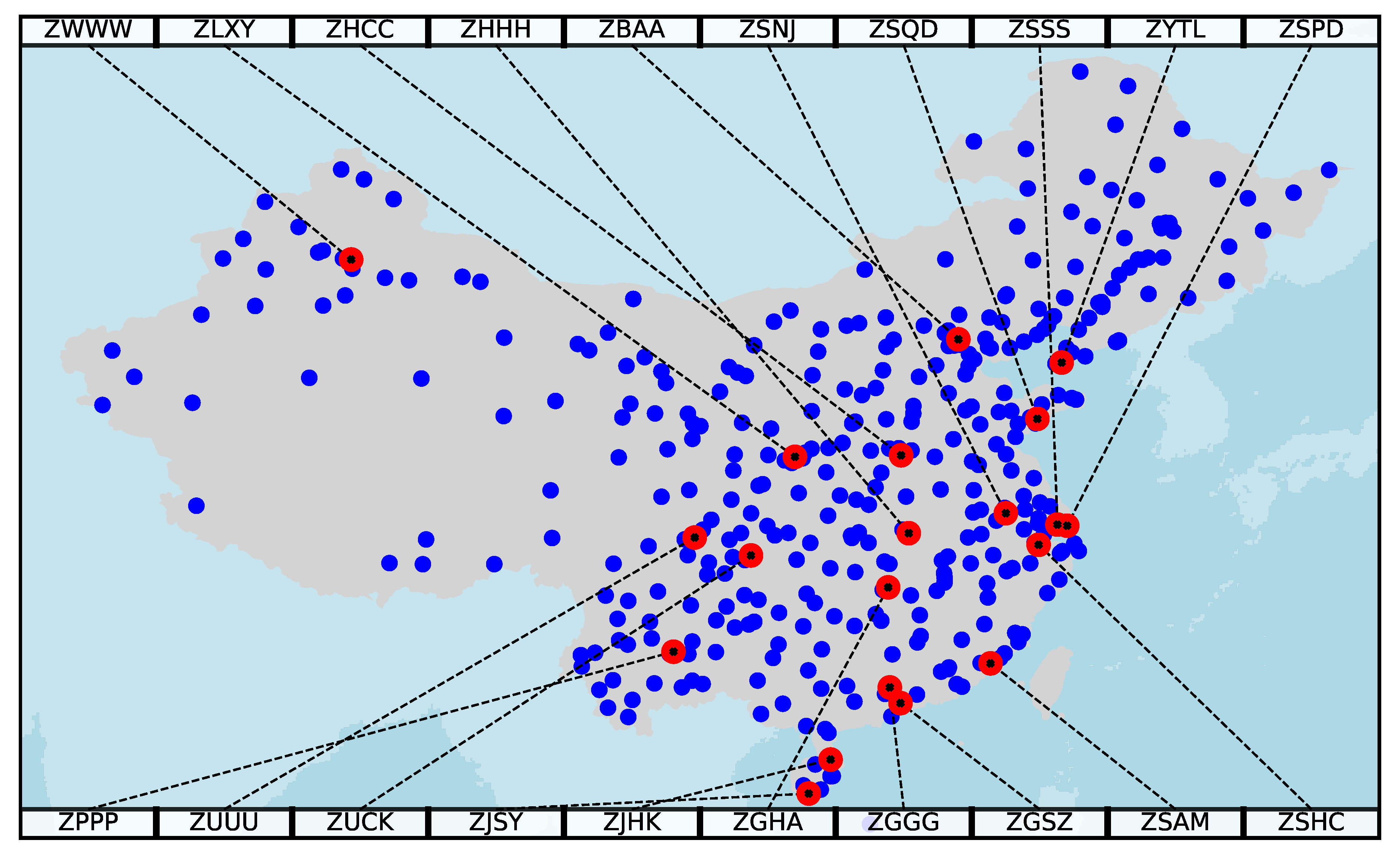
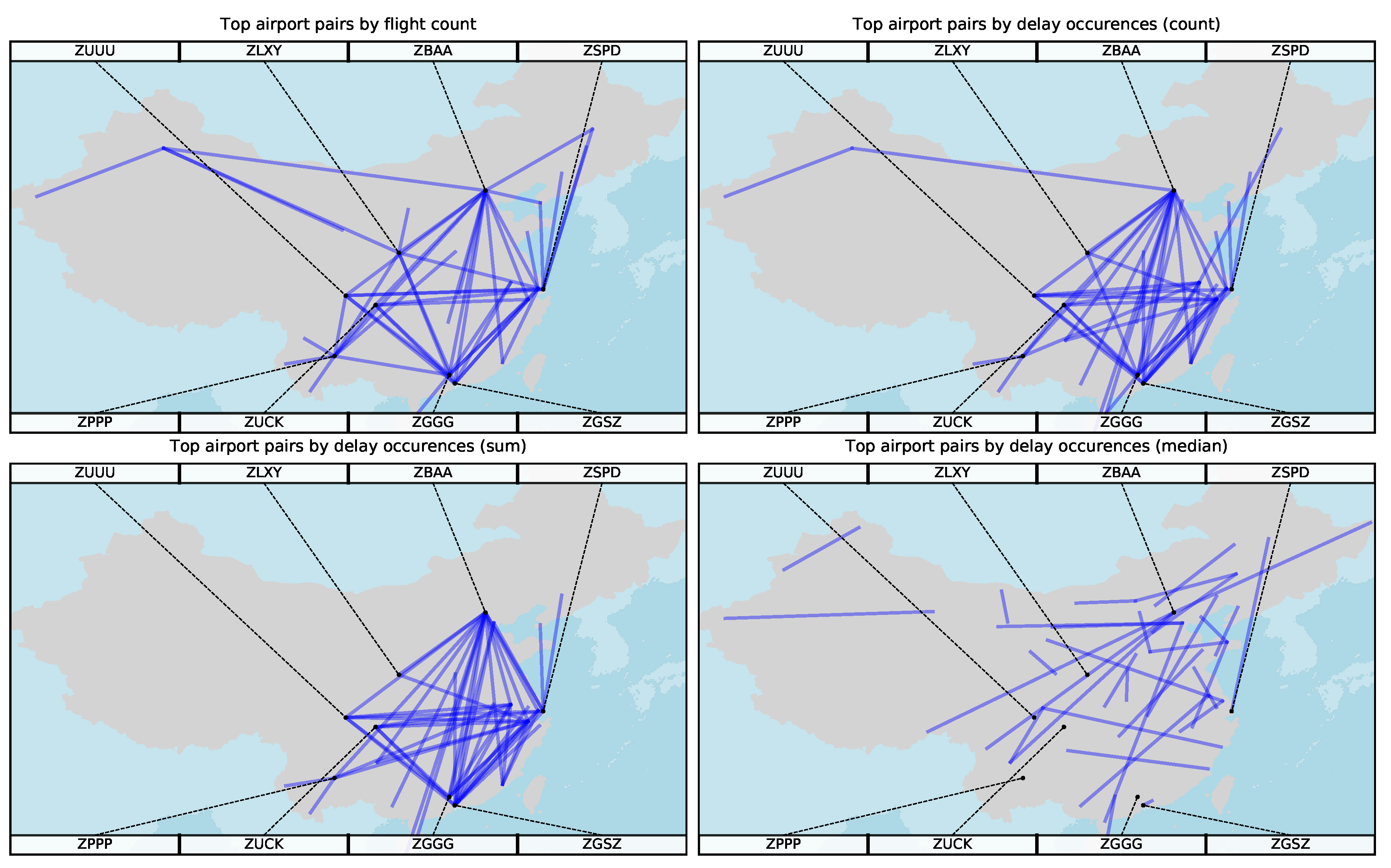
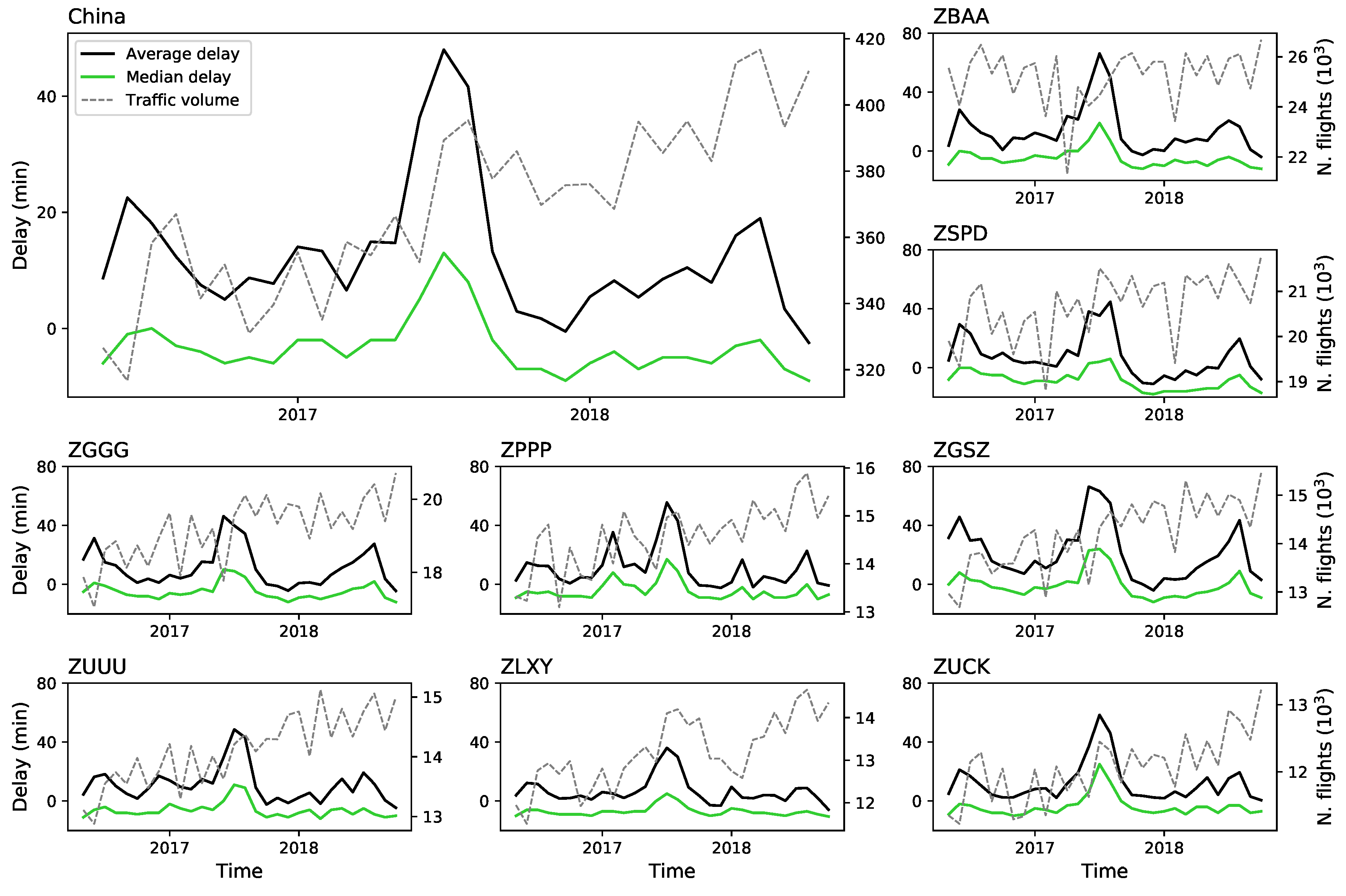
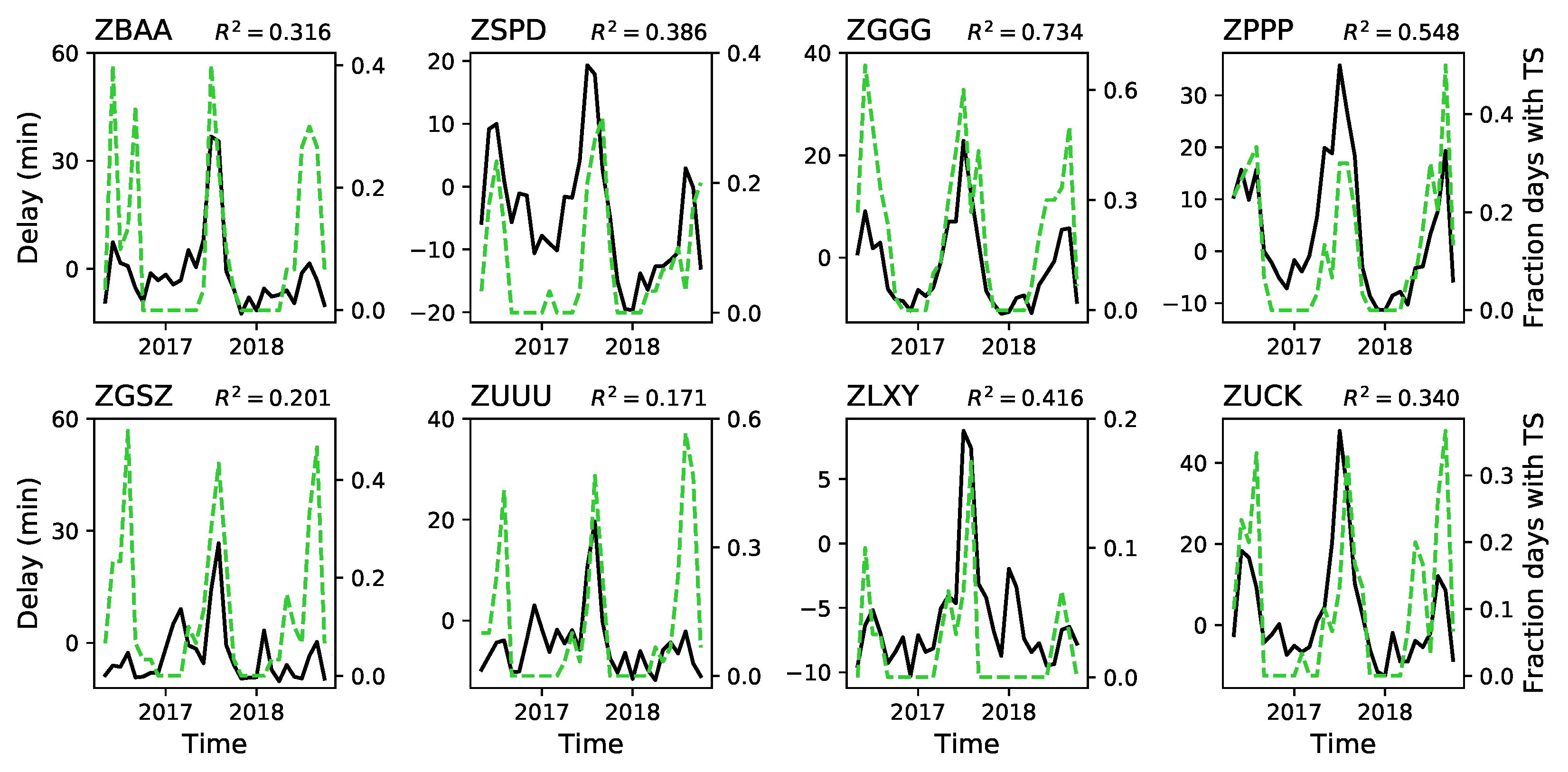
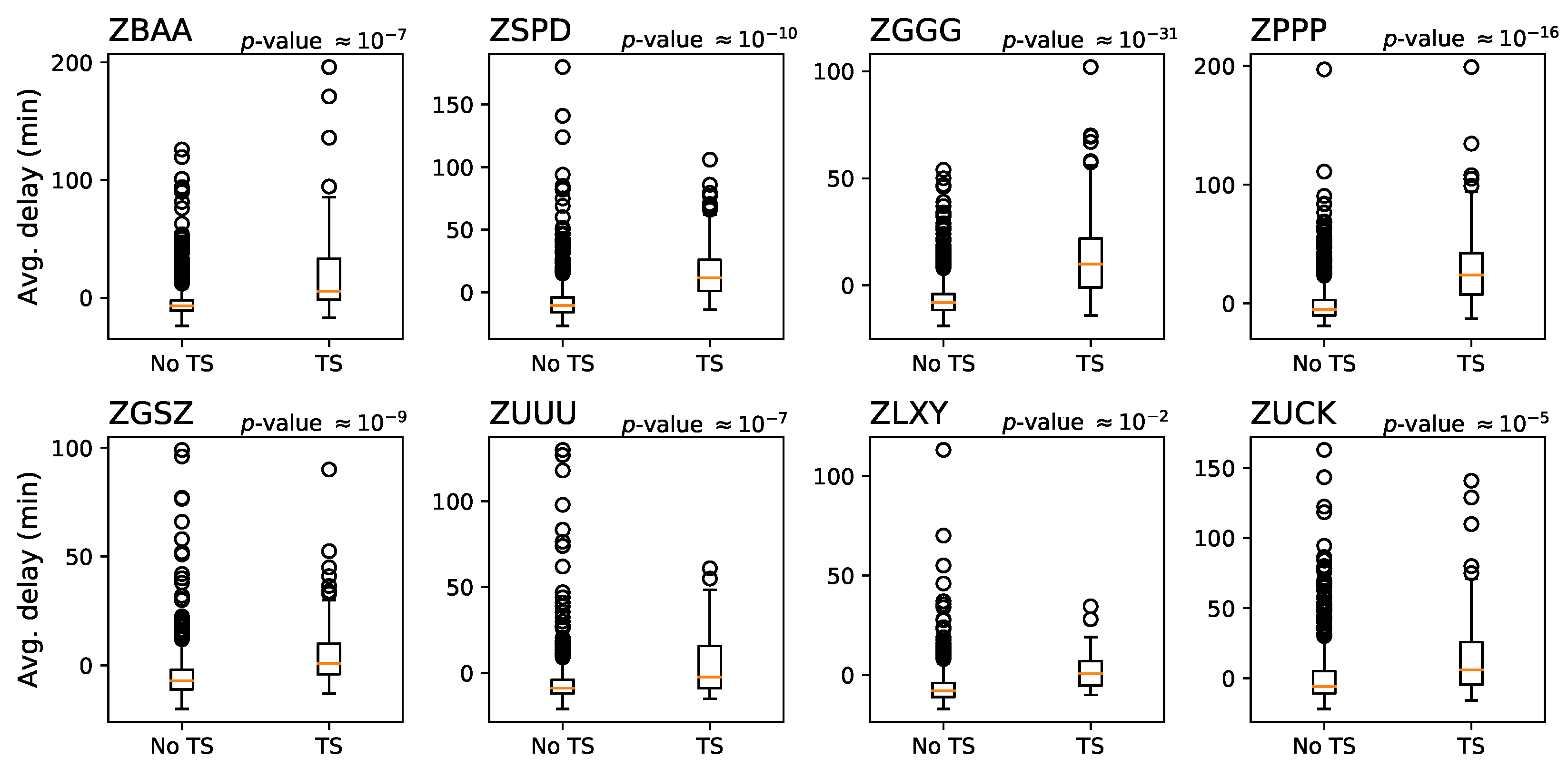
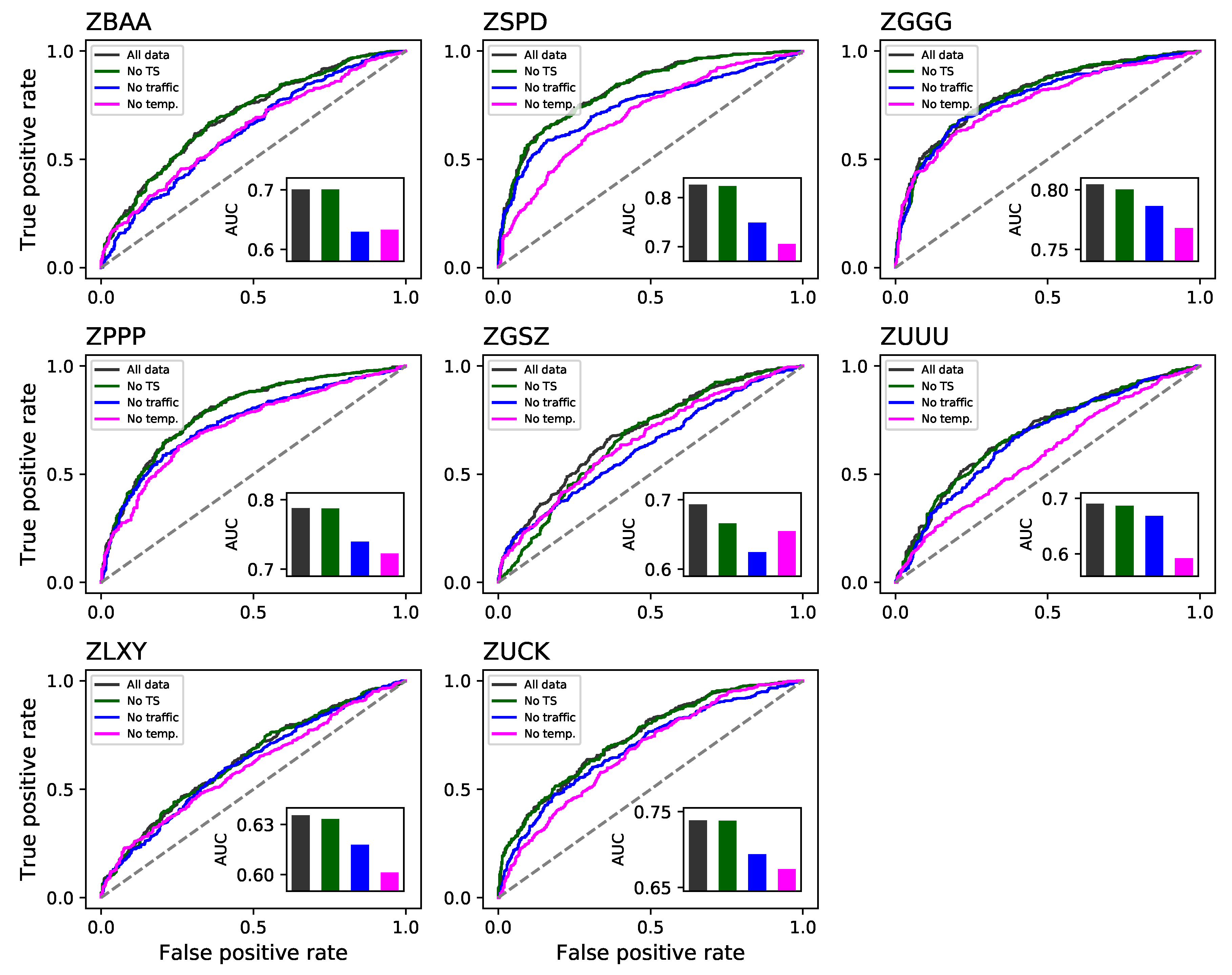

| Airport | 2016.05–2016.10 | 2016.11–2017.04 | 2017.05–2017.10 | 2017.11–2018.04 | 2018.05–2018.11 |
|---|---|---|---|---|---|
| Domestic | |||||
| ZBAA | |||||
| ZSPD | |||||
| ZGGG | |||||
| ZPPP | |||||
| ZGSZ | |||||
| ZUUU | |||||
| ZLXY | |||||
| ZUCK |
| Airport | pV Summer (2016 vs. 2017) | pV Winter (2016 vs. 2017) | pV Summer (2017 vs. 2018) |
|---|---|---|---|
| Domestic | 0.1302 | 0.0149 | 0.0739 |
| ZBAA | 0.1342 | 0.0267 | 0.0950 |
| ZSPD | 0.4065 | 0.0870 | |
| ZGGG | 0.2649 | 0.0471 | 0.2108 |
| ZPPP | 0.1435 | 0.0808 | 0.1176 |
| ZGSZ | 0.3270 | 0.0158 | 0.1383 |
| ZUUU | 0.1593 | 0.1350 | |
| ZLXY | 0.0625 | 0.3979 | 0.0294 |
| ZUCK | 0.0667 | 0.2846 | 0.0642 |
| Airport | Temperature | Wind Speed | Rain | Visibility | Thunderstorm | AQI |
|---|---|---|---|---|---|---|
| ZBAA | ||||||
| ZSPD | ||||||
| ZGGG | ||||||
| ZPPP | – | |||||
| ZGSZ | – | |||||
| ZUUU | ||||||
| ZLXY | – | |||||
| ZUCK | – |
| Airport | Temperature | Wind Speed | Rain | Visibility |
|---|---|---|---|---|
| ZBAA | ||||
| ZSPD | ||||
| ZGGG | ||||
| ZPPP | ||||
| ZGSZ | ||||
| ZUUU | ||||
| ZLXY | ||||
| ZUCK |
© 2020 by the authors. Licensee MDPI, Basel, Switzerland. This article is an open access article distributed under the terms and conditions of the Creative Commons Attribution (CC BY) license (http://creativecommons.org/licenses/by/4.0/).
Share and Cite
Zanin, M.; Zhu, Y.; Yan, R.; Dong, P.; Sun, X.; Wandelt, S. Characterization and Prediction of Air Transport Delays in China. Appl. Sci. 2020, 10, 6165. https://doi.org/10.3390/app10186165
Zanin M, Zhu Y, Yan R, Dong P, Sun X, Wandelt S. Characterization and Prediction of Air Transport Delays in China. Applied Sciences. 2020; 10(18):6165. https://doi.org/10.3390/app10186165
Chicago/Turabian StyleZanin, Massimiliano, Yanbo Zhu, Ran Yan, Peiji Dong, Xiaoqian Sun, and Sebastian Wandelt. 2020. "Characterization and Prediction of Air Transport Delays in China" Applied Sciences 10, no. 18: 6165. https://doi.org/10.3390/app10186165
APA StyleZanin, M., Zhu, Y., Yan, R., Dong, P., Sun, X., & Wandelt, S. (2020). Characterization and Prediction of Air Transport Delays in China. Applied Sciences, 10(18), 6165. https://doi.org/10.3390/app10186165







